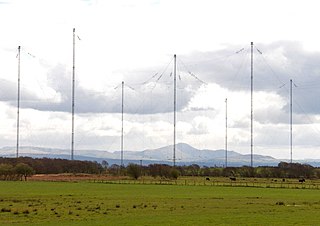Related Research Articles
The Isle of Man has an extensive communications infrastructure consisting of telephone cables, submarine cables, and an array of television and mobile phone transmitters and towers.
The Time from NPL is a radio signal broadcast from the Anthorn Radio Station near Anthorn, Cumbria, which serves as the United Kingdom's national time reference. The time signal is derived from three atomic clocks installed at the transmitter site, and is based on time standards maintained by the UK's National Physical Laboratory (NPL) in Teddington. The service is provided by Babcock International, under contract to the NPL. It was funded by the former Department for Business, Innovation and Skills; as of 2017 NPL Management Limited (NPLML) was owned by the Department for Business, Energy and Industrial Strategy (BEIS), and NPL operated as a public corporation.

CFRC-FM is the non-commercial campus radio station at Queen's University in Kingston, Ontario, Canada. The station has one of the longest radio histories in Canada, with experimental broadcasts dating back to 1922 and serves Queen's University students and faculty as well as the greater Kingston community. CFRC-FM is also a member of the National Campus and Community Radio Association.
A UK Restricted Service Licence, is typically granted to radio stations and television stations broadcasting within the UK to serve a local community or a special event. Licences are granted by the broadcasting authority Ofcom.

Rugby Radio Station was a large British government radio transmission facility just east of the Hillmorton area of the town of Rugby, Warwickshire in England. The site straddled the A5 trunk road, with most of it in Warwickshire, and part on the other side of the A5 in Northamptonshire. First opened in 1926, at its height in the 1950s it was the largest radio transmitting station in the world, with a total of 57 radio transmitters, covering an area of 1,600 acres (650 ha). Traffic slowly dwindled from the 1980s onwards, and the site was closed between 2003 and 2007.

Anthorn Radio Station is a naval and government radio transmitting station located near Anthorn, Cumbria, England, overlooking the Solway Firth, and is operated by Babcock International. It has three transmitters: one VLF; one LF; and an eLORAN transmitter.

FM broadcasting is a method of radio broadcasting that uses frequency modulation (FM) of the radio broadcast carrier wave. Invented in 1933 by American engineer Edwin Armstrong, wide-band FM is used worldwide to transmit high-fidelity sound over broadcast radio. FM broadcasting offers higher fidelity—more accurate reproduction of the original program sound—than other broadcasting techniques, such as AM broadcasting. It is also less susceptible to common forms of interference, having less static and popping sounds than are often heard on AM. Therefore, FM is used for most broadcasts of music and general audio. FM radio stations use the very high frequency range of radio frequencies.
The Orfordness transmitting station was a major radio broadcasting facility at Orford Ness on the Suffolk coast in the United Kingdom able to broadcast to much of Europe. It closed in May 2012 after more than 30 years of service. In 2017 Radio Caroline started broadcasting from the site, though not with the same intended coverage of an audience in Europe as the original station.

HMS Forest Moor was a Royal Navy land base located in Nidderdale in the borough of Harrogate, North Yorkshire, England.
VT Group is a privately held United States defense and services company, with its origins in a former British shipbuilding group, previously known as Vosper Thornycroft. The British part of VT Group was integrated into Babcock International in the early 2010s. In July 2012, The Resolute Fund II, LP, an affiliate of The Jordan Company acquired VT Group.

CINW was the final call sign used by an English language AM radio station in Montreal, Quebec, which, along with French-language sister station CINF, ceased operations at 7:00 p.m. ET on January 29, 2010. Owned and operated by Corus Quebec, it broadcast on 940 kHz with a full-time power of 50,000 watts as a clear channel, Class A station, using a slightly directional antenna designed to improve reception in downtown Montreal.
CIRR-FM was a radio station in Toronto, Ontario. Owned by Evanov Communications, it broadcast a rhythmic contemporary format with a focus on the area's LGBT community. Launching on April 16, 2007, it was the first radio station in Canada targeted specifically to an LGBT audience, and the first commercial, terrestrial radio station in the world to target such an audience. It was one of six stations in Toronto that reports to Nielsen BDS' Canadian Top 40 airplay panel.

The Woofferton transmitting station is owned and operated by Encompass Digital Media, as one of the BBC's assets which were handed over as part of the privatization of World Service distribution and transmission in 1997. It is the last remaining UK shortwave broadcasting site, located at Woofferton, south of Ludlow, Shropshire, England. The large site spreads across into neighbouring Herefordshire.
Babcock International Group plc is a British aerospace, defence and nuclear engineering services company based in London, England. It specialises in managing complex assets and infrastructure. Although the company has civil contracts, its main business is with public bodies, particularly the United Kingdom's Ministry of Defence and Network Rail. The company has four operating sectors, with overseas operations based in Africa, North America, South America, Europe and Australia.

Anthorn is a village in Cumbria, England. Historically in Cumberland, it is situated on the south side of the Solway Firth, on the Wampool estuary, about 13 miles (21 km) west of Carlisle. It is the location of the Anthorn radio station, broadcasting specialised low frequency signals for timekeeping and navigation.

Hawkesbury Radio is an Internet radio station situated in the Hawkesbury Area.

Kiss 101 was a radio station in Bristol, England that broadcast to South Wales and the West of England, playing pop, dance, hip hop, urban, R&B and electronic music.
The Breeze formerly Quay West and Total Star Somerset was an Independent Local Radio station serving the Sedgemoor District, Bridgwater and West Somerset.

The Defence High Frequency Communications Service or the DHFCS is a British military beyond line-of-sight communication system operated by the Ministry of Defence (MOD) and used predominately by the UK Armed Forces, as well as other authorised users. The system operates from six transmitting and receiving sites across the United Kingdom and is controlled from a network control centre located at Forest Moor in North Yorkshire and a backup site at Kinloss Barracks in Moray. Overseas sites are located in Ascension Island, Cyprus and Falkland Islands. In 2003 VT Merlin Communications were awarded the contract to operate the system for a period of fifteen years on behalf of the Ministry of Defence. The system is to be replaced by the Defence Strategic Radio Service (DSRS) also operated by Babcock
Between 1978 and 2023, the BBC Far Eastern Relay Station broadcast radio programmes addressing the largest audiences in Asia of the BBC World Service. The site at Kranji, Singapore, complemented transmission facilities in the United Kingdom, Cyprus, Hong Kong and Oman. Each was built on a vast scale, and were complex, because they transmitted multiple radio programmes simultaneously to different destinations. However, in essence the stations had a simple function: to convert electricity from the grid into radio frequency energy, to superimpose the programme signal, and finally to radiate the energy with such high power that programmes could be heard using inexpensive, hand-held, battery powered radios with short telescopic antennas across wide areas of the world.
References
- ↑ "VT Communications opens new centre for Defence High Frequency Communications". Association for International Broadcasting. 19 June 2006. Retrieved 18 October 2017.
- ↑ Babcock Acquisition